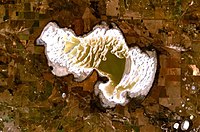
Photo from wikipedia
Generally, a sensing structure with high sensitivity has a small dynamic measurement range and vice versa. A simple combination method of Mach–Zehnder-interferometer (MZI) and a modal interference (MI) for salinity… Click to show full abstract
Generally, a sensing structure with high sensitivity has a small dynamic measurement range and vice versa. A simple combination method of Mach–Zehnder-interferometer (MZI) and a modal interference (MI) for salinity measurement is studied. It achieves performance with high sensitivity and a large measurement range. Here, the sensitivity of the MZI is higher than that of the MI by about two orders in magnitude. Then the MZI composed of large offset splicing single-mode fiber (SMF) structure is adopted to work for high-sensitivity measurement of salinity. While the MI is composed of a photonic crystal fiber (PCF) spliced with two SMF is adopted to extend the measurement range of the MZI structure. After a proper data processing algorithm, it can meet the requirement of salinity measurement in seawater. According to experiments and data processing results, the sensitivity of the proposed method could be up to −16602.8 nm/refractive index unit (RIU) in the range of 1.333–1.341, which is corresponding to 3.32056 nm/‰ in the salinity range of 0‰–40 ‰ at 25 °C. The proposed method could effectively expand the measurement range of high-sensitivity MZI according to the requirement, and also has the potential for multiparameter measurement.
Journal Title: IEEE Transactions on Instrumentation and Measurement
Year Published: 2022
Link to full text (if available)
Share on Social Media: Sign Up to like & get
recommendations!